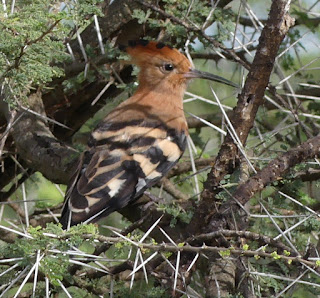Last week we had a five day excursion to Same and the Magamba Forest above Lushoto. This was essentially a birding expedition to increase Steve’s Life List but I found plenty to entertain myself as well!
We went with a Norwegian friend (who is far more familiar with Tanzania’s birds than even Steve) and a Tanzanian friend. We had two nights in a hotel in Same and two nights camping in the forest.
Same is the town close to the Mkomazi NP and the birding we did was in woodland close to the park boundary. Steve had a list of ‘targets’ but I was happy to see a couple of my favourites - the African Hoopoe and the Abyssinian Scimitar bill (these photos are Steve’s but not from this trip), a very interesting plant (Caralluma speciosa) and some industrious dung beetles.

The more interesting part of the trip was the time we spent in the forest. Magamba Forest is a government forest reserve in the West Usambara Mountains. The road up to Lushoto from Mombo is steep and windy. It was built pre WW1 and is called “the German road”. Lushoto was where expats went to escape the heat and humidity of the coast in colonial times. The road is tarmacked and in very good condition. Culverts and bridges are in bluestone with pretty arches. It just shows if something is made properly it will last! The down hill side of the road is lined with eucalypt trees - blue gum, spotted gum, swamp gum - all the way up. This was supposed to stabilise the soil and prevent land slips and it seems to have worked! At each hairpin bend there was a gushing waterfall - some muddy, some crystal clear, depending on the land use above them. It rained all the way up the mountain and I was silently contemplating the folly of camping during the rainy season.
 |
The road from Lushoto up to our camp in the forest was steep, wet and very muddy. Slipping into the gutter would be disaster! But luckily it didn’t happen thanks to an ancient LandRover and some very competent Norwegian driving.
Our camp was in an abandoned sawmill so theoretically we were protected from rain but as we were in the cloud it was damp everywhere. Getting a fire started took remarkable persistence - no one had thought to pack firelighters, or even dry paper and corn chips! It really was a very comfortable camp and despite the Forest Department officer’s concerns that we’d be cold - she sent a pikipiki rider up from the reserve’s headquarters with a bag of old curtains to use as extra blankets! - we stayed warm and dry.
The sawmill has been non-operational for several decades but in its heyday it must have been something special. There was the mill building (where we camped) which still had some of the machinery. It had been powered by a steam engine undoubtedly fed with wood waste and saw dust. There was a large shed stacked with sawn timber, now well and truly cured! It is a resource that should be used by whoever has ownership. Then there were the administrative offices in a solid brick building and still with all the filing cupboards and office equipment in place. There were many residences I guess for the bosses, not the ‘workers’. What we presumed to be the manager’s house was quite a mansion complete with swimming pool and magnificent garden. There were assorted other, mainly weatherboard, cottages in various states of disrepair. All had English gardens. There were hydrangeas, fuschias and roses along the road and into the forest as well as arum and other lilies. It was quite magical!
The ‘birding’ consisted of walking the road close to the camp. The forest was too wet and too thick to venture too far off the road. Birds are hard to hear and even harder to see. It’s a job for which I have neither the patience or perseverance needed. So I just enjoyed the walks! Steve at one point tried to get a photo of the river we could see rushing below us and nearly ended up in it. His fall was arrested by a chameleon (the West Usambara Two-horned Chameleon) which didn’t seem to suffer too much from the experience.
 |
 |
| Steve had to return to the scene of the crime to retrieve his binoculars |
The Usambara Mountains are part of the eastern arc mountains that run from north to south in Tanzania. The natural biodiversity both plant and animal is astonishing. There are still new plants and animals to be discovered by those intrepid enough to try. We know a herpetologist, a neighbour here in Arusha, who has identified many new species of frogs and toads just by going in to the forests and having a good look. He camps for weeks at a time in the forest collecting samples.
As well as, or even possibly despite, the natural diversity there are invasive species in the forests in both the Usambara and Pare mountains. Locals like to plant eucalypts which are fast growing and have no natural enemies. There are also pines, which along with eucalypts and Australian acacias, have ‘escaped’ from managed plantations. It is sad to see them but I don’t think the native trees are suffering too much from their presence.
As we plan for what may be our last week here in Tanzania we can reflect on having made the most of our time and maybe we’ll sneak in one last trip to Arusha NP before Friday next week when we are due to fly home. Fingers crossed that they’ll be no last minute SNAFU though as the acronym makes clear they are ‘normal’ especially in this part of the world.
You’ll all know soon how it goes, keep watching for a blog from Steve with his perspective!
Love from Jenny











No comments:
Post a Comment